Welcome to our exploration of the vibrant world of hummingbirds! These stunning avian species are like mesmerizing hummingbird species, often referred to as the flying jewels of nature. With their unique characteristics and vibrant plumage, they are truly captivating to observe. In the United States and Canada, we are fortunate to have a diverse array of these beautiful hummingbirds adorning our skies.
From the tiny and colorful Ruby-throated Hummingbird to the majestic Calliope Hummingbird, each species brings its own charm and beauty. These vibrant feathered creatures are not only a delight to the eyes but also valuable pollinators, making them important contributors to our ecosystems.
Join us on this journey as we introduce you to some of the most gorgeous hummingbird species found in North America. We’ll explore their habitat, migration patterns, and fascinating behaviors. From the breathtaking Rufous Hummingbird to the captivating Broad-tailed Hummingbird, you’ll discover a world filled with colorful garden visitors and vibrant flying jewels.
Ruby-throated Hummingbird
The Ruby-throated Hummingbird is a common sight in the United States during the summer months. With its vibrant green feathers and brilliant red throat, it is a stunning bird to behold. These hummingbirds migrate all the way to Mexico for the winter, making their journey across the Gulf of Mexico.
To attract Ruby-throated Hummingbirds, it is recommended to hang a nectar feeder and plant red, tubular flowers in your garden. These small birds primarily feed on nectar from flowers and can be seen darting in and out of gardens in search of their favorite food source.
They build small, cup-shaped nests in trees or shrubs to lay their eggs.
Ruby-throated Hummingbirds are the only species of hummingbirds that breed in the eastern United States.
Rufous Hummingbird
The Rufous Hummingbird is a delightful tiny bird that captivates us with its vibrant colors and remarkable behavior. Known for its distinctive migration pattern, this species follows a route along the Pacific Coast in spring and the Rocky Mountains in fall, making it a unique and awe-inspiring sight.
“The Rufous Hummingbird is a true marvel of nature. Its journey along the coast and across the mountains showcases its resilience and adaptability.”
This hummingbird species exhibits assertiveness and territorial behavior, often chasing away other hummingbirds from its preferred feeding areas. Its vibrant orange-red plumage and white breast make it easy to spot among the flowers and foliage. Despite its small size, the Rufous Hummingbird possesses impressive strength and agility, performing acrobatic flights that leave us in awe.
The Rufous Hummingbird can be found in a variety of habitats, including coniferous forests and mountain meadows. It is well adapted to these environments, utilizing the available resources to thrive and survive. Its ability to navigate through dense vegetation and hover near flowers demonstrates its exceptional flying skills.
This species’ behavior and appearance make it a valuable addition to any birdwatcher’s observations. Its presence brings joy and excitement to our natural surroundings, reminding us of the beauty and diversity of avian life.
To give you a visual glimpse of the stunning Rufous Hummingbird, take a look at the image below:
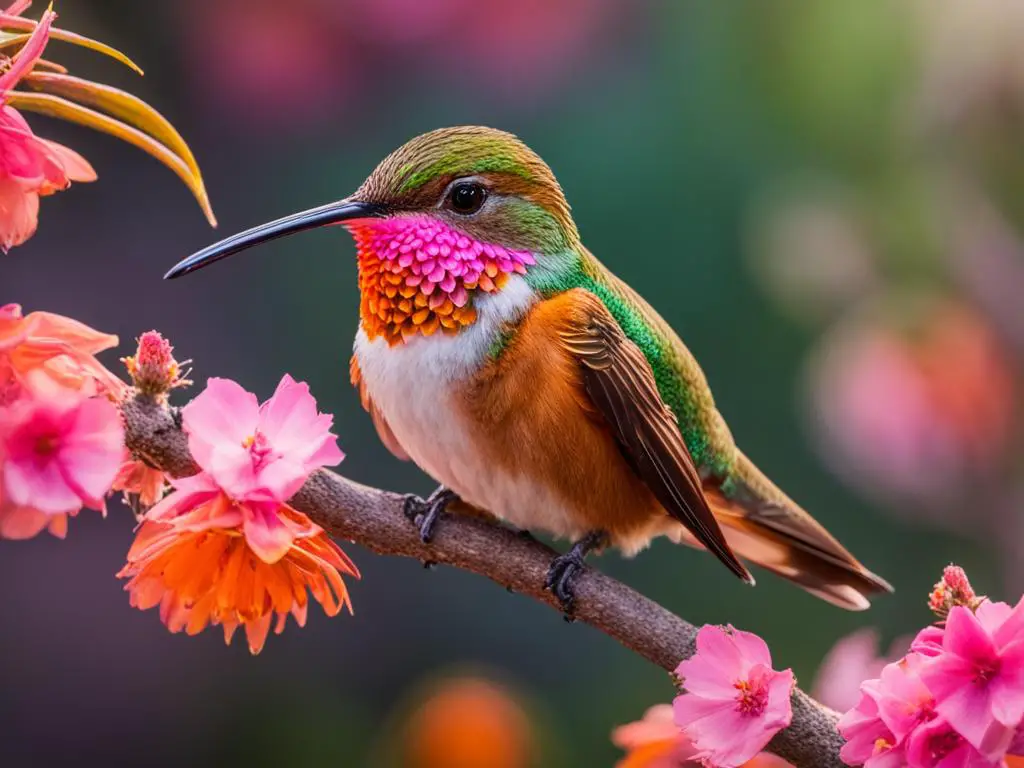
Whether observed during migration or as a resident in its preferred habitat, the Rufous Hummingbird never fails to impress us with its charm and tenacity. Its captivating presence is a testament to the wonders of the natural world we share.
Black-chinned Hummingbird
The Black-chinned Hummingbird is a fascinating species known for its metallic green body, white breast, and greenish flanks. These petite birds bring joy to birdwatchers and garden enthusiasts alike with their vibrant colors and delicate presence. Let’s explore more about the black-chinned hummingbird’s migration, habitat, and breeding habits.
Migration Patterns
The Black-chinned Hummingbird embarks on an incredible journey from its breeding grounds in the United States to the west coasts of Mexico for the winter. This migratory pattern showcases their extraordinary ability to navigate and travel long distances. As these agile birds make their way to their wintering grounds, they provide a spectacle for observers along their route.
Habitat Preferences
Black-chinned Hummingbirds can be found in a variety of habitats, especially western forests, during the breeding season. These habitats provide them with the necessary resources, including food and nesting sites, to thrive and raise their young. It’s a delightful sight to see them flitting among the trees, sipping nectar from flowers, and displaying their graceful flight.
Breeding Behavior
When it comes to breeding, Black-chinned Hummingbirds are meticulous architects. They construct their tiny nests using materials such as spider silk and plant down, creating a comfortable and secure environment for their eggs. Despite their diminutive size, their dedication to building nests showcases their resourcefulness and commitment to the next generation.
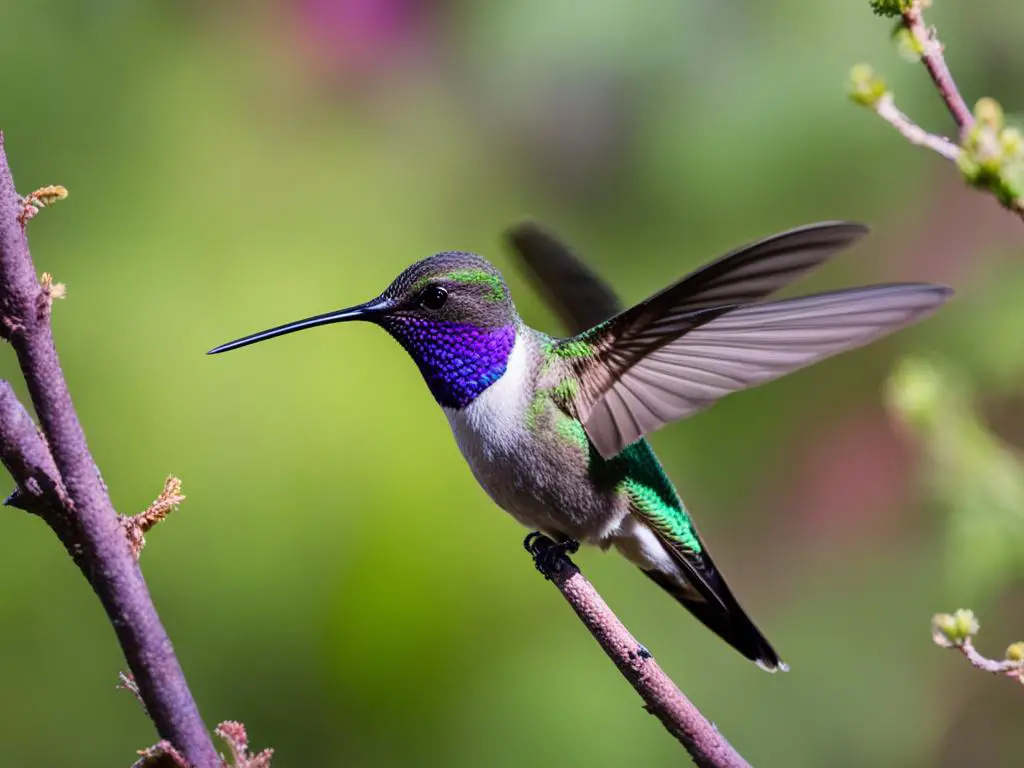
Quick Facts: Black-chinned Hummingbird
| Scientific Name | Archilochus alexandri |
|---|---|
| Size | 3.5-4 inches (8-10 cm) in length |
| Weight | 0.1-0.2 ounces (3-6 grams) |
| Wingspan | 4-6 inches (10-15 cm) |
| Plumage | Metallic green body, white breast, greenish flanks |
| Eggs | Two small eggs, smaller than jellybeans |
| Conservation Status | Least Concern |
These facts give us a glimpse into the remarkable characteristics of the Black-chinned Hummingbird and the importance of preserving their habitats for future generations to appreciate and cherish.
Calliope Hummingbird
The Calliope Hummingbird is a fascinating species and holds the title of being the smallest bird in the United States. This tiny hummingbird showcases an enchanting combination of green plumage and vibrant magenta streaks on its throat, making it a truly unique and captivating sight.
When it comes to migration, Calliope Hummingbirds follow an interesting pattern. In the spring, they embark on a journey up the Pacific coast, while in the fall, they migrate south along the Rocky Mountains. These birds prefer habitats such as western forests and can be found in areas with high elevations. Despite their small size, Calliope Hummingbirds are resilient and continue to thrive in their preferred environments.
To gain a better understanding of the Calliope Hummingbird’s behavior, let’s take a closer look at some key characteristics:
Size:
The Calliope Hummingbird measures just 3-3.75 inches (8-9.5 cm) in length, with a wingspan of approximately 4.25 inches (11 cm).
Feeding:
Like other hummingbirds, Calliopes primarily feed on nectar from flowers. Their long, slender bills allow them to reach deep into tubular blossoms to extract the sweet nectar. In addition to nectar, they also consume small insects and spiders as a source of protein.
Behavior:
Calliope Hummingbirds are known for their energetic and agile flight. They can hover in mid-air, fly backwards, and even execute intricate aerial maneuvers. These birds are territorial and often defend their feeding and nesting areas from intruders, displaying their assertive nature.
Conservation Status:
The Calliope Hummingbird is considered a species of least concern on the International Union for Conservation of Nature (IUCN) Red List. However, it is still important to protect their habitats and contribute to hummingbird conservation efforts to ensure their long-term survival.
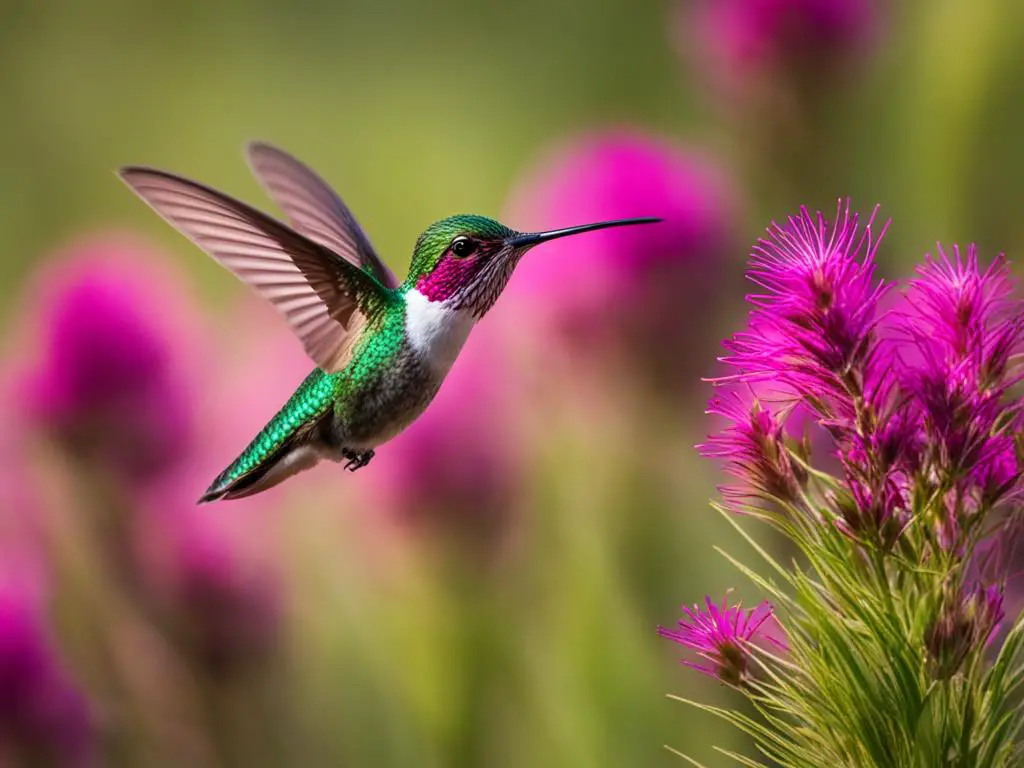
Observing a Calliope Hummingbird in the wild is a true delight, as it showcases the remarkable beauty and resilience of these tiny avian wonders. From their vibrant plumage to their agile flight capabilities, they continue to captivate birdwatchers and nature enthusiasts alike.
Stay tuned to discover more about the stunning hummingbird species found in the United States and Canada in the next section.
Broad-tailed Hummingbird
The Broad-tailed Hummingbird is a captivating species known for its stunning iridescent green back, head, and tail, accentuated by an exquisite red throat. These beautiful birds grace the United States from late May to early August, primarily favoring the enchanting landscapes of western forests.
One distinctive characteristic of the Broad-tailed Hummingbird is its unique chattering noise, which adds to its charm and allure. Additionally, the gentle hum of their wings resembles the soothing sound of crickets, creating a harmonious ambiance in their presence.
Watching these incredible hummingbirds in action is a delight, as they gracefully flit from flower to flower, feeding on nectar with their long, slender beaks. Their agility and precision in flight are truly mesmerizing to observe.
Whether you’re an avid birdwatcher or simply a lover of nature’s beauty, the Broad-tailed Hummingbird is sure to captivate your heart. Consider creating a hummingbird-friendly garden with their favorite nectar-rich flowers and provide a clean and well-stocked hummingbird feeder to attract these delightful creatures to your natural haven. It’s a wonderful way to experience their beauty up close while contributing to their thriving population.
Lose yourself in the enchantment of the Broad-tailed Hummingbird. Marvel at their vibrant colors, listen to their melodic sounds, and embrace the joy they bring to any garden or natural setting.
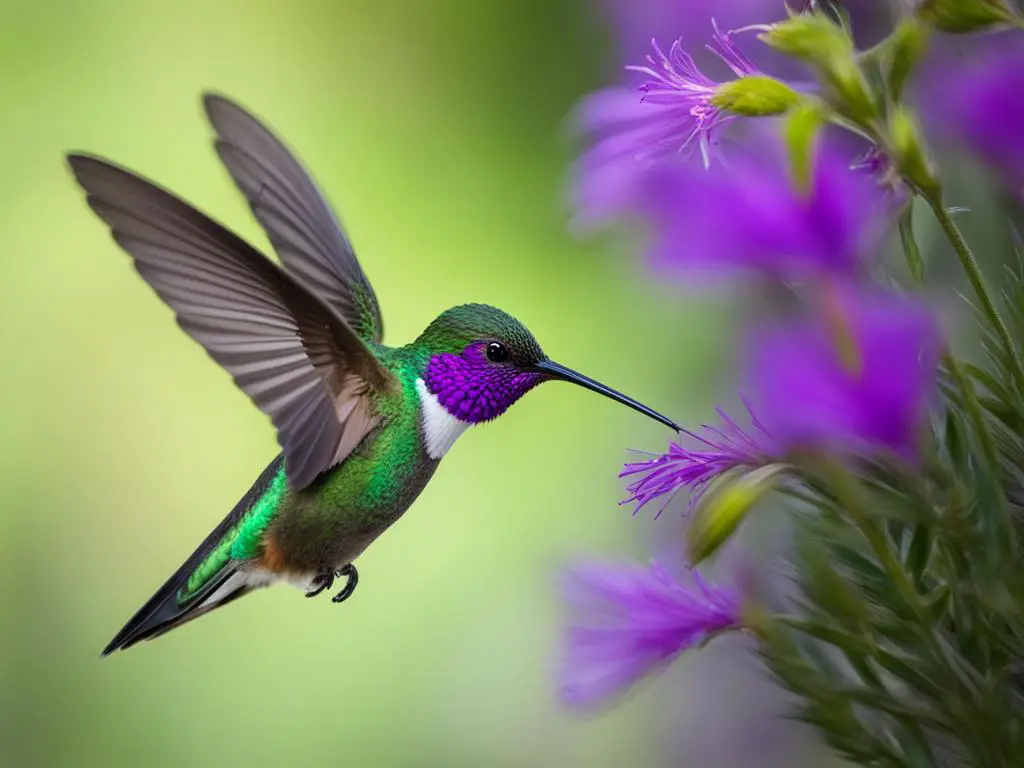
| Common Name | Broad-tailed Hummingbird |
|---|---|
| Scientific Name | Selasphorus platycercus |
| Migration | Northward migration begins in spring, southward migration in fall |
| Habitat | Western forests, aspen groves, mountain meadows |
| Behavior | Distinctive chattering noise, flits rapidly between flowers, exceptional flight agility |
Other Hummingbird Species in the US and Canada
In addition to the aforementioned hummingbirds, there are several other species that can be found in the United States and Canada. Each of these species has its own unique characteristics and habitat preferences, adding variety and beauty to the avian world.
Allens’s Hummingbird
Allens’s Hummingbird is known for its stunning iridescent green and red plumage. These vibrant birds can be found along the western coast of the United States and into Mexico. With their swift flight and distinct buzzing sound, they are a delight to observe in their natural habitat.
Blue-throated Hummingbird
The Blue-throated Hummingbird, as the name suggests, has a beautiful blue throat that contrasts with its green feathers. These hummingbirds can be found in the southwestern United States and parts of Mexico. They are known for their preference for high-altitude habitats and their impressive ability to hover in mid-air.
Lucifer Hummingbird
The Lucifer Hummingbird is a striking bird with its vibrant pinkish-purple throat and green body. They can be found in the southwestern United States and into Mexico. These hummingbirds are known for their distinctive courtship displays, where the males perform acrobatic flights to attract females.
Magnificent Hummingbird
The Magnificent Hummingbird lives up to its name with its dazzling combination of green and purple plumage. These hummingbirds are primarily found in the southwestern United States and northern Mexico. They have a distinctive long, straight bill and are known for their fierce territorial behavior.
Buff-bellied Hummingbird
The Buff-bellied Hummingbird features a unique combination of bright green upperparts and a buff-colored belly. These hummingbirds can be found along the Gulf Coast of the United States and into Mexico. They prefer habitats such as woodlands, gardens, and parks with abundant nectar sources.
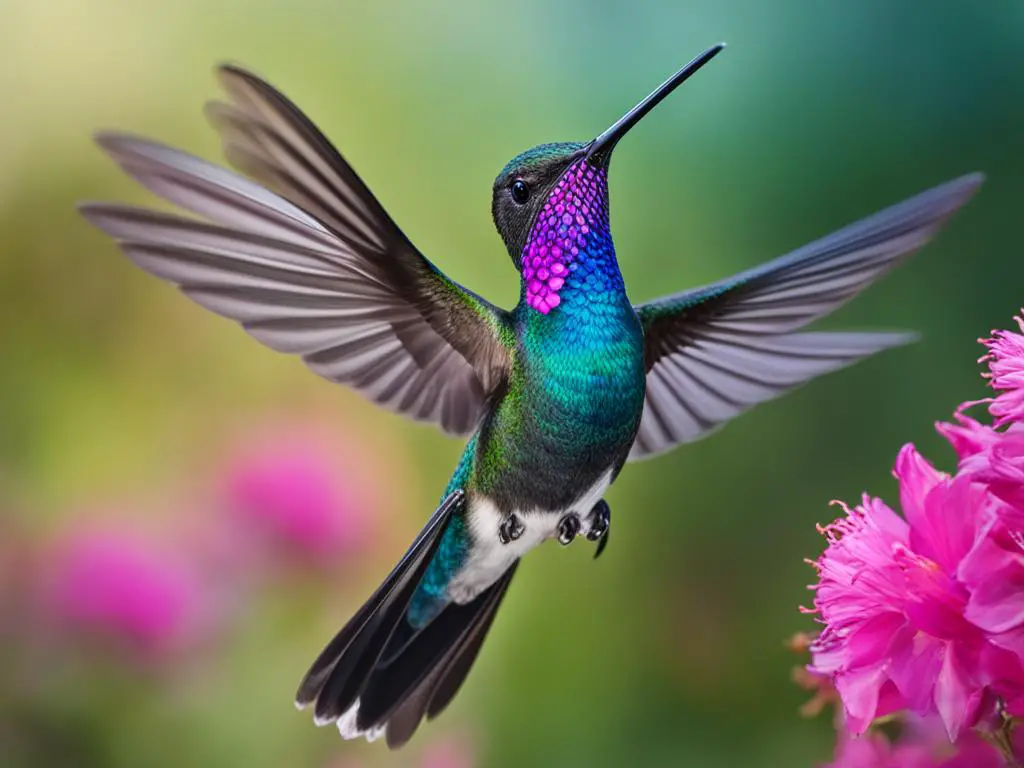
Blue-throated Hummingbird Facts:
| Common Name | Blue-throated Hummingbird |
|---|---|
| Scientific Name | Lampornis clemenciae |
| Size | Approximately 4.7 inches (12 cm) long |
| Range | Southwestern United States and parts of Mexico |
| Habitat | High-altitude pine and oak forests |
| Diet | Nectar from a variety of flowers, small insects |
| Migration | Some individuals may migrate south for the winter |
“The Blue-throated Hummingbird is a true gem of the Southwest, with its vibrant colors and unique habitat preferences. Observing its iridescent plumage and listening to its distinctive call is an experience like no other.” – Hummingbird enthusiast
Hummingbird Facts and Behavior
Hummingbirds are truly fascinating creatures with their unique flight patterns, feeding behavior, and vibrant plumage. With over 330 different species identified, hummingbirds are a diverse group of birds that captivate birdwatchers and nature enthusiasts alike. In North America, we can find a variety of hummingbirds, each with its own stunning colors and distinctive characteristics. Their ability to hover and fly in place is truly remarkable, setting them apart from other birds.
The feeding behavior of hummingbirds is a marvel to behold. While they primarily feed on nectar from flowers, they also consume insects and spiders as a source of protein. Their long, thin beaks allow them to reach deep into tubular flowers to extract nectar with their specialized tongues. This unique feeding adaptation is why they are often referred to as “nectarivores.”
“Hummingbirds are like tiny helicopters, capable of flying in all directions and even hovering in mid-air. It’s truly astonishing to witness their agility and control.” – Birdwatcher
The vibrant plumage of hummingbirds is a sight to behold. Their feathers come in a wide range of colors, from iridescent greens and blues to vibrant reds and purples. This colorful display is not only visually stunning but also serves various purposes, such as attracting mates and establishing territories.
To further understand the behavior of hummingbirds, researchers have conducted extensive studies on their mating rituals, courtship displays, and migration patterns. These studies have revealed fascinating insights into their complex social behaviors and incredible navigation abilities.
North American Hummingbird Species
There are several species of hummingbirds found in North America, each with its own unique characteristics and range:
| Hummingbird Species | Distinctive Features | Range |
|---|---|---|
| Ruby-throated Hummingbird | Vibrant green feathers with a brilliant red throat | Eastern United States and Canada |
| Rufous Hummingbird | Bright orange-red plumage with a white breast | Western United States and Canada |
| Black-chinned Hummingbird | Metallic green body with a white breast | Western United States and Mexico |
| Calliope Hummingbird | Green plumage with vibrant magenta streaks on the throat | Western United States and Canada |
| Broad-tailed Hummingbird | Iridescent green back, head, and tail with an exquisite red throat | Western United States and Canada |
These are just a few examples of the stunning hummingbird species found in North America. Each species has its own unique habitat preferences and migration patterns, making them an exciting subject of study for ornithologists and bird enthusiasts.
If you’re interested in spotting and identifying hummingbird species, it’s essential to familiarize yourself with their distinctive features, such as plumage color, beak shape, and size. A field guide or online resource can be helpful in identifying different hummingbird species.
Observing hummingbirds in their natural habitat is a rewarding experience. Whether you’re lucky enough to have a hummingbird visit your garden or you spot one during a nature hike, take a moment to appreciate these remarkable creatures and the beauty they bring to the world.
Hummingbird Conservation
Hummingbirds, like many other bird species, are facing threats to their habitat and populations. We are committed to the conservation of these beautiful and unique birds through various initiatives. By focusing on hummingbird conservation, we can help ensure that these delightful creatures continue to grace our gardens and skies for generations to come.
One of the key aspects of hummingbird conservation is protecting these birds from agricultural pesticides. These chemicals can have a devastating impact on hummingbird populations, as they rely on nectar from flowers as their primary food source. By advocating for responsible pesticide use and promoting alternatives, we can create safer environments for hummingbirds.
Another important aspect of conservation is promoting responsible cat ownership. Domestic cats, especially those allowed to roam freely outdoors, can pose a significant threat to hummingbirds. By keeping cats indoors or in enclosed outdoor spaces, we can reduce the risk of predation and ensure the safety of these fragile birds.
Glass collisions are another major threat to hummingbirds. Their high-speed flight and small size make them particularly vulnerable to colliding with windows and glass structures. To mitigate this risk, we can take simple measures such as installing bird-friendly window treatments or placing window decals that make the glass more visible to birds.
Habitat preservation is crucial for the long-term survival of hummingbirds. By conserving and restoring natural habitats such as forests, meadows, and wetlands, we provide essential foraging and nesting areas for these birds. Additionally, planting native flowering plants in our gardens can create valuable habitat patches that attract hummingbirds and provide them with the nectar they need.
We believe that education and awareness play an essential role in hummingbird conservation. By spreading the word about the importance of preserving these unique bird species, we can inspire others to take action. Public outreach programs, educational materials, and community engagement initiatives are powerful tools for raising awareness about the conservation needs of hummingbirds.
“Hummingbirds are not only captivating to observe, but they also play a vital role in pollination, making them essential contributors to our ecosystem. By conserving their habitats and protecting them from threats, we are safeguarding not only the hummingbirds themselves but also the biodiversity and ecological balance of our natural world.”
Together, through our collective efforts, we can make a difference in hummingbird conservation. By protecting them from pesticides, supporting responsible cat ownership, reducing glass collisions, and preserving their habitats, we can help ensure the survival of these stunning birds. Let’s join hands in this important endeavor and celebrate the beauty and resilience of hummingbirds.
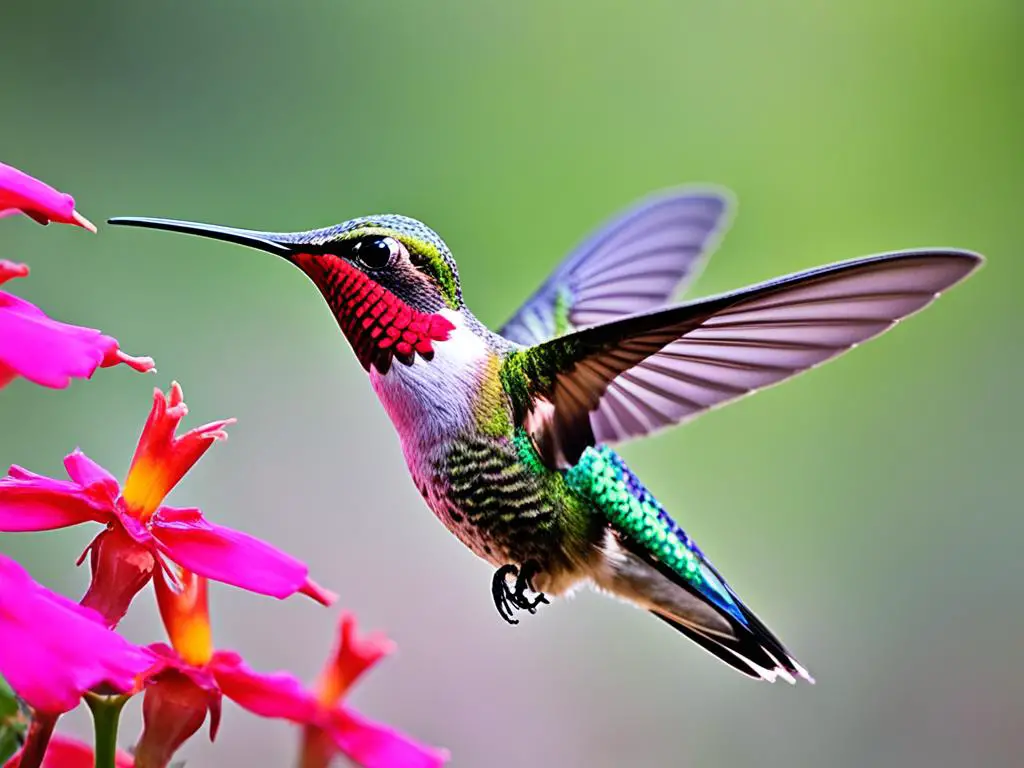
The Impacts of Conservation Efforts
Conservation efforts have shown promising results in safeguarding hummingbirds and their habitats. Through dedicated initiatives, we have witnessed the recovery of hummingbird populations in certain regions and the establishment of protected areas specifically designed to support their needs. By monitoring and studying these bird populations, researchers continue to gather valuable insights into their behavior, migration patterns, and habitat requirements.
Furthermore, projects that focus on habitat restoration and the creation of native plant gardens have not only attracted hummingbirds but have also contributed to the conservation of other pollinators and wildlife species. These efforts provide a holistic approach to conservation, promoting biodiversity and supporting the natural balance of ecosystems.
| Threats to Hummingbirds | Conservation Measures |
|---|---|
| Agricultural pesticides | Advocacy for responsible pesticide use and promoting alternatives |
| Irresponsible cat ownership | Encouraging responsible cat ownership and keeping cats indoors or in enclosed outdoor spaces |
| Glass collisions | Installation of bird-friendly window treatments and decals |
| Habitat loss and degradation | Habitat preservation and restoration, planting native flowering plants |
| Lack of awareness | Education, outreach programs, and community engagement initiatives |
Attracting Hummingbirds to Your Garden
Creating a hummingbird-friendly garden is a great way to support these beautiful birds and enjoy their vibrant presence in your yard. To attract hummingbirds, you can take a few simple steps.
1. Plant Nectar-Rich Flowers
Hummingbirds are attracted to nectar-producing flowers with tubular shapes. Some popular hummingbird-friendly plants include:
| Plant | Scientific Name |
|---|---|
| Bee balm | Monarda spp. |
| Cardinal flower | Lobelia cardinalis |
| Columbine | Aquilegia spp. |
| Trumpet creeper | Campsis radicans |
By incorporating these plants into your garden, you’ll provide a natural food source for hummingbirds and create an inviting habitat.
2. Set Up Hummingbird Feeders
In addition to flowers, you can supplement hummingbirds’ diet by placing hummingbird feeders in your garden. These feeders contain a sugar-water solution that mimics the nectar found in flowers.
When choosing a feeder, opt for one with bright colors (red is a popular choice) to attract hummingbirds. Make sure to clean and refill the feeder regularly to prevent bacteria growth.
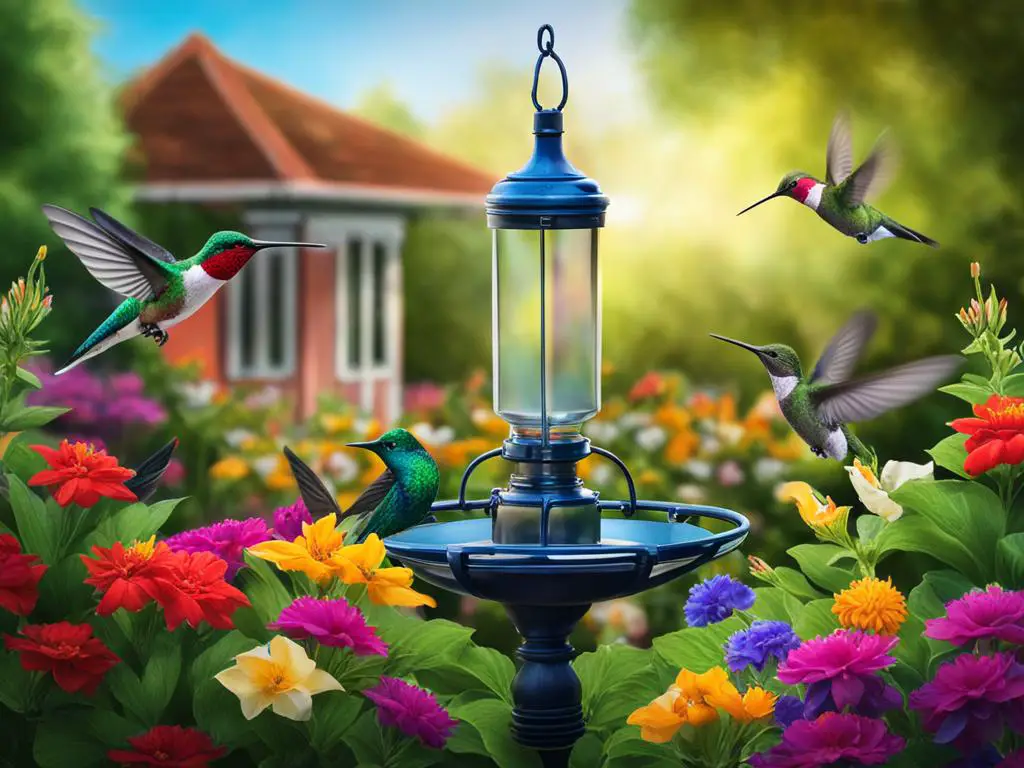
3. Provide Water Sources
Hummingbirds need water not only for drinking but also for bathing. Consider adding a shallow birdbath or misting device to your garden. These water sources will attract hummingbirds and provide them with the opportunity to groom and cool off.
Hummingbirds are nature’s tiny jewels, and by creating a hummingbird garden, we can invite these enchanting creatures into our lives and contribute to their well-being.
By following these tips and creating a hummingbird-friendly garden, you’ll not only attract these beautiful birds but also contribute to their conservation. So embrace the beauty of hummingbirds in your own backyard and enjoy the calming and mesmerizing moments they bring.
Conclusion
In conclusion, the presence of hummingbirds in the US and Canada brings an unparalleled beauty to our skies. These mesmerizing creatures with their vibrant plumage and acrobatic flight never fail to captivate our hearts. By understanding their behavior, habitat preferences, and conservation needs, we can play an active role in preserving their existence.
Creating hummingbird-friendly gardens is a simple yet effective way to attract and support these stunning birds. Planting nectar-rich flowers such as bee balm and trumpet creeper, and providing a clean and well-stocked hummingbird feeder, ensures a reliable food source for these colorful garden visitors. Additionally, supporting conservation efforts that focus on habitat preservation and raising awareness about the importance of bird conservation can make a significant impact.
Let us celebrate the diversity and beauty of these gorgeous hummingbirds and take responsibility for their protection. Our collective efforts will not only ensure their survival but also contribute to the preservation of our natural ecosystems. So, let’s continue to admire and safeguard these amazing creatures for generations to come.
FAQ
What are some examples of gorgeous hummingbirds found in the US and Canada?
Some examples of gorgeous hummingbirds found in the US and Canada include the Ruby-throated Hummingbird, Rufous Hummingbird, Black-chinned Hummingbird, Calliope Hummingbird, and Broad-tailed Hummingbird. There are also other species such as Allen’s Hummingbird, Blue-throated Hummingbird, Lucifer Hummingbird, Magnificient Hummingbird, and Buff-bellied Hummingbird.
What is unique about the Ruby-throated Hummingbird?
The Ruby-throated Hummingbird is a common sight in the United States during the summer months. It has vibrant green feathers and a brilliant red throat. These hummingbirds migrate to Mexico for the winter and primarily feed on nectar from flowers. They build small, cup-shaped nests in trees or shrubs to lay their eggs.
What is the migration pattern of the Rufous Hummingbird?
The Rufous Hummingbird has a distinctive migration pattern along the Pacific Coast in spring and the Rocky Mountains in fall. Known for their aggressive behavior and territorial nature, Rufous Hummingbirds have a stocky body, bright orange-red plumage, and a white breast.
Where do Black-chinned Hummingbirds migrate and breed?
Black-chinned Hummingbirds migrate to the west coasts of Mexico for the winter and breed in the United States during the summer. With a metallic green body, white breast, and greenish flanks, they can be found in habitats such as western forests.
How does the Calliope Hummingbird differ from other hummingbirds?
The Calliope Hummingbird is the smallest bird in the United States. It has green plumage and vibrant magenta streaks on the throat. These hummingbirds have an interesting migration pattern, flying up the Pacific coast in spring and south along the Rocky Mountains in fall. They prefer habitats such as western forests and areas with high elevations.
What are the characteristics of the Broad-tailed Hummingbird?
The Broad-tailed Hummingbird has an iridescent green back, head, and tail, with a red throat. They stay in the United States from late May to early August and primarily inhabit western forests. Broad-tailed Hummingbirds have a unique chattering noise and the hum of their wings resembles the sound of crickets.
What are some other hummingbird species found in the US and Canada?
In addition to the aforementioned hummingbirds, there are other species found in the US and Canada such as Allen’s Hummingbird, Blue-throated Hummingbird, Lucifer Hummingbird, Magnificient Hummingbird, and Buff-bellied Hummingbird. Each species has its own unique characteristics and habitat preferences.
What are some interesting facts about hummingbirds?
Hummingbirds are a diverse group of birds with over 330 different species identified. In North America, there are various types of hummingbirds with stunning colors and distinctive characteristics. They are known for their unique flight patterns, feeding behavior, and vibrant plumage. Hummingbirds primarily feed on nectar from flowers but also eat insects and spiders.
How can we help with hummingbird conservation?
Hummingbird conservation efforts focus on protecting their habitat and populations. This includes promoting responsible cat ownership, reducing glass collisions, improving habitat management, and raising awareness about the importance of conservation. By preserving and creating suitable habitats, we can help ensure the survival of these beautiful and unique bird species.
How can I attract hummingbirds to my garden?
You can attract hummingbirds to your garden by planting nectar-rich flowers such as bee balm, cardinal flower, columbine, and trumpet creeper. Additionally, maintaining a clean and well-stocked hummingbird feeder can provide a reliable food source. Creating a hummingbird-friendly garden is a great way to support their populations and enjoy their beauty.

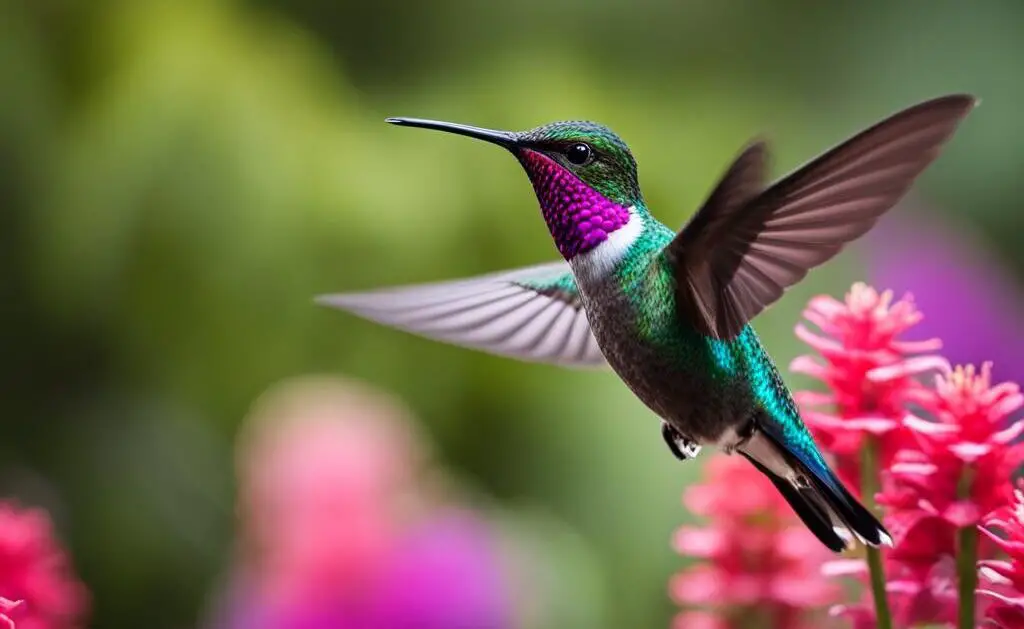
Comments are closed